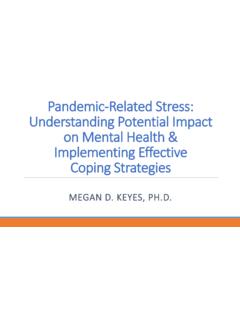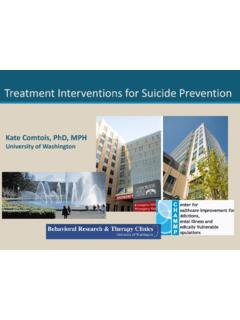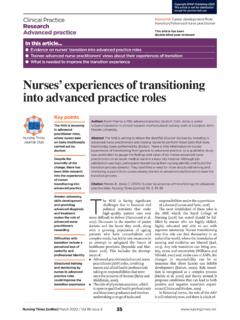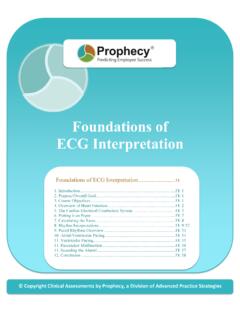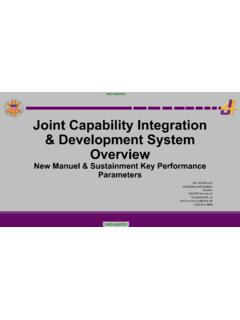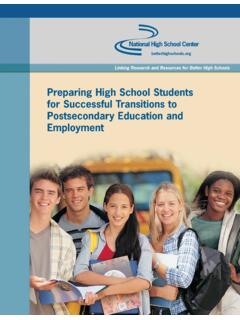Transcription of School-based Strategies in Preventing Youth Suicide
1 School-based Strategies in Preventing Youth SuicideThe Role of Schools in Preventing Youth SuicideBackground From case to cause: schools as the intersection of practice and policy Competent Suicide risk assessments requires a competent workforce training programs lack formal curriculum Poor training leads to over or under assessment of risk Fear of liability leads to utilization of the most restrictive interventions School policies are informed by this workforce Few evidence-based assessment procedures leading to reduction in Suicide Difficulty in differentiating individuals who attempt Suicide vs. those who die by Suicide vs. those who never attempt suicideWe need innovations in research to: Improve our capacity to identify individuals at risk for Suicide Improve our capacity to differentiate between individuals likely to attempt Suicide and those unlikely to attempt Suicide Improve our understanding of suicidal trajectories Improve help-seekingThe Scope Global emotional, economic, and societal costs are significant but difficult to quantify Estimated economic burden in the is between $ billion annually ~800,000losses to Suicide each year globally1 ~ million US adults think about Suicide each year2 ~ million US adults make a plan to end their life each year2 ~ million US adults attempt Suicide each year2 In 2018-201947,511people died by Suicide in the US3 In 2018-201914.
2 547youth and young adults 10-34 died by suicide3; of all deaths by suicideTABLE. Annual number and age-adjusted rate of Suicide per 100,000, AGE GroupingsSuicidality in High School Students in the United StatesThe Scope 2ndleading cause of death for Youth and young adults3 90% of those who die by Suicide meet criteria for at lease one mental disorder4 20% of children and adolescents meet criteria for a mental disorder at any given time5 60-70% of Youth meeting criteria for any mental disorder do not access mental health service6 ~20% of Youth who die by Suicide accessed specialty mental healthcare in the previous year of Youth who die by Suicide accessed specialty mental health care in the month prior to their death Most Youth who meet criteria for any mental disorder do not know it6 Schools Represent a Unique and Strategic Role In Preventing Suicide4.
3 Cavanaugh, J., Carson, A., Sharpe, M. & Lawrie, S. (2003). Psychological autopsy studies of Suicide : A systematic review. Psychological Medicine, 33:1, Merkangas, , He, J., Burstein, M., Swanson, , Avenevoli, S., Cui, L., Benjet, C., Georgiades, K., & Swendsen, L. (2010). Lifetime prevalence of mental disorders in adolescents: Results from the National Comorbidity Study-Adolescent Supplement (NCS-A). Journal of the American Academy of Child and Adolescent Psychiatry. 49(10): 980-989. , , Alegria, M., Cohen, P., Goodman, , Horwitz, , Hoven, C., Narrow, , Vaden-Kiernan, M., & Regier, D. (1996). Mental health service use in community and schools: Results from the four-community MECA survey. Journal of the American Academy of Child and Adolescent Psychiatry, 35(7): 889-897.
4 , , Gurewich, D., Lwin, , Reed, , & Silverman, (2015). Suicide and Suicide attempts in the United States: Costs and policy implications. Suicide and Life-threatening Behavior, 46(1), 352-362. School Response Systems Can Prevent Suicide Schools represent the nexus of Youth experience Schools create natural access points for screening, identification, intervention, and services School responses can influence Youth help-seeking and self-disclosure Schools, if prioritized, can be structurally organized to prevent Suicide in youthSchool-based mental health services have the potential to reduce disparities in access, quality, and mental health outcomesfor youthHope Policy AcademySuicide Prevention, Intervention, and PostventionPolicy WorkshopsCOMPREHENSIVE Suicide PREVENTION IN SCHOOLSS uicide is Absolutely PreventableComprehensive Suicide Prevention Model for Schools Tier 1: Universal Strategies .
5 Targets entire school community Programs designed to increase awareness, screening and referral ( gatekeeper trainings; QPR) Tier 2: Selected Strategies : Targets students at-risk of developing suicidal behavior Programs to strengthen self-regulation of behavior and emotions (Good Behavior Game; Social & emotional learning curriculum) Tier 3: Indicated Strategies : Targets Students already identified as suicidal Programs designed to address suicidality or emotional and behavioral disorders ( School-based mental health services)School Response Systems Can Prevent SuicideSchool-based SuicidePreventionSchool-based Risk Assessment, Intervention, and Management (AIMS) School-based PostventionSupport and ActivitiesTarget Audience:Faculty, Staff, Administration, Students, CaregiversTarget Audience:Staff and AdministrationStudents as partnersTargetAudience: Faculty, Staff, Administration, Students, Caregivers, CommunityFunctions:AwarenessScreeningRef erralPreventing Pathwaysto SuicideFunctions.
6 SuicideRisk AssessmentInterventionManagement Preventing SuicideFunctions: Grief/losssupportive services Healing effortsPreventing contagionStructural Strategies :PoliciesImplementationPlanPro ceduresProtocolsStructural Strategies :PoliciesImplementationPlanPro ceduresProtocolsStructural Strategies :PoliciesImplementationPlanPro ceduresProtocolsPolicy= the overarching rules or framework at the district levelImplementation Plan = the roadmap for getting to where they wish to be (we are at x and we need to get to y)Procedure= School level enactment of the district policy which defines how the school implements prevention, AIMS, andpostvention. The process level of who does what, when they do it, and under what criteria. The what includes the forms and steps.
7 Protocol= the practice level instructions for the school personnel to follow, which includes how and what to do when a student is identified at risk for Suicide . Suicide PREVENTION IN SCHOOLSS chool-Based Suicide Prevention A comprehensive School-based Suicide prevention program will utilize various approaches and should not rely on one prevention method. Rather programs should implement and maintain numerous prevention Strategies in order to effectively prevent adolescent Suicide . (YSPG) Student education, gatekeeper training , screening, community connection, and skills training are Strategies which should be used in conjunction with one another to inform an effective Suicide prevention policy General Best Practices for Suicide Prevention Programs Provide education Organize the right people to lead Suicide prevention efforts Articulate clear scope of practice, roles.
8 & responsibilities Train ALL faculty and staff in gatekeeper training -frequently and repeatedly Provide information for parents and caregivers Train on Counseling on Access to Lethal Means Train students through Suicide Awareness Curriculum Express explicit prioritization by Administrators Take efforts to improve school climate through improving connectedness, diversity and inclusion, and an institutional commitment to equityElements of Suicide Prevention Policy Education and Fact Sheets about Risk, Protective Factors, and Warning Signs for Staff & Faculty Suicide Awareness Curriculum for Students gatekeeper training for Staff & Faculty Screening Establishment of a Crisis Response Team Evaluation of Suicide Prevention Efforts Educating and Collaborating with Parents and Community Members Teaching Adaptive Skills to Students Peer Support GroupsGatekeeper training for Staff All staff must receive gatekeeper training and be aware of all relevant protocols prior to students receiving prevention education or screening Last approximately 2 hours and be provided at least every 2-3 years Recognizing students at risk Intervention & communication Determining/Assessing level of risk Referral practices Should be universal and evidence-based Clarify role.
9 Expected to act as gatekeeper , not meant to act as mental health provider tasked to recognize risk and sound the alarm Research shows that teachers and school staff believe that Suicide prevention is an important part of their role, but they lack the tools or confidence necessary to fill the role. Effective training and clear expectations can fill this gap and empower teachers and other staff to actively prevent Suicide in their schools. Effective Models: Maine s Youth Suicide prevention program Colorado s safe communities -Safe schools program Washington s Youth Suicide prevention program ASAP, Suicide prevention Unit-Los Angeles unified school district. Prevention Education for Students Aids in identifying and supporting at-risk students Utilizes a mental health model Taught over multiple sessions Provides information about Warning signs, risk and protective factors Statistics and dispelling myths Resources in the community Help-seeking Strategies Enhance Youth capacity to identify peers and teach them how to link peers to resources.
10 Student Suicide Prevention Education Parameters: Use a gradual approach Use a mental health model rather than a stress model to prevent destigmatizing suicidal behavior Use multiple sessions and link to education on substance use, bullying, racism and marginalization. Avoid single-session curriculum as been shown to be harmfulPotential Tool: Green Card program-students receive card with instructions and contact informationEffective Models: Washington Youth Suicide Prevention Program, Safe: Teen, Lifelines, Adolescent Suicide Awareness ProgramFamily and Community Involvement in School-based Suicide Prevention Engagement with local organizations/agencies Counseling on access to lethal means Engage families in Suicide prevention efforts through education Engage early Engage often Engage prior to crisis Additional Strategies for Prevention Screening Direct assessment within 7 days if at risk Positive school climate Peer support groups Can be used to provide additional support for at-risk students (not a replacement for therapy) Increases likelihood of seeking help Teaching problem-solving, coping, social, and help-seeking skills May prevent suicidal behavior and violence Why Screening?

